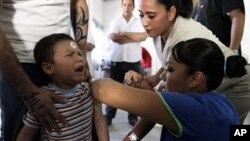The World Health Organization says the world is better prepared for the next influenza pandemic than it was in the past. More than 100 public health experts have wrapped up a three-day meeting in Geneva to review a Global Action Plan for Influenza Vaccines that was developed in 2006, and to develop a strategic plan of action for the next five years. .
The 2006 Global Action Plan for Influenza Vaccines was triggered in response to the H1N1 influenza outbreaks in May 2006. It aims to help countries increase their ability to protect their population from influenza pandemic.
The centerpiece of the plan, known as GAP I, was to strengthen the capacity of manufacturers to provide enough vaccines to immunize the world’s population against influenza.
WHO Assistant Director-General on Innovation, Information, Evidence and Research Marie-Paule Kieny says there have been a number of successes. They include new developments in production methods, new rules governing vaccine delivery and progress toward, what she calls the holy grail of influenza vaccination, the development of a universal vaccine.
She notes pandemic vaccine production has increased markedly from 350 million doses in 2006 to more than 800 million doses now. She says the Global Action Plan also has changed the landscape of vaccine production.
She tells VOA the Global Action Plan is helping manufacturers in 11 developing countries produce or increase production of influenza vaccines through financial and technology transfers.
“What we have already done, the global community, and we are continuing to do is to make sure that not only will there be more influenza pandemic vaccine if need be, but also that the site where these vaccines will be produced will be more diverse geographically," said Marie-Paule Kieny. "And thanks to this diversity more populations of the world will have earlier access to pandemic vaccines of what was the case in the past.”
Dr. Kieny says no one can predict when the next pandemic will occur. She notes vaccines can only be produced at the time the virus is known. This means manufacturers are always in a race against time to produce large quantities of an effective vaccine as quickly as possible.
During the H1N1 pandemic, she says manufacturers in developing countries did not have the ability to produce a pandemic vaccine quickly. She cites the example of India, where it took several manufacturers about a year to make a vaccine available.
“They now have the technology in place and would be capable, like their counterparts, like large manufacturers who have started immediately at the time of the pandemic and had vaccines available three months after that," said Marie-Paule Kieny. "They are now in a position where they can also go for the same objective-start at the time of a pandemic and have a vaccine available within three months.”
The World Health Organization reports the nearly 40 manufacturers around the world producing pandemic vaccines originate mainly in industrialized countries. But it says more companies are springing up in low and middle-income countries.
It says new production of pandemic vaccines are established in Brazil, Korea, India and Romania. And, the establishment of new manufacturing capacity for influenza vaccine is ongoing in Egypt, Indonesia, Iran, Mexico, Serbia, Thailand, and Vietnam.
WHO Says World Better Prepared for Next Influenza Pandemic
- By Lisa Schlein









